Dina Katabi
Single-Teacher View Augmentation: Boosting Knowledge Distillation via Angular Diversity
Oct 26, 2025Abstract:Knowledge Distillation (KD) aims to train a lightweight student model by transferring knowledge from a large, high-capacity teacher. Recent studies have shown that leveraging diverse teacher perspectives can significantly improve distillation performance; however, achieving such diversity typically requires multiple teacher networks, leading to high computational costs. In this work, we propose a novel cost-efficient knowledge augmentation method for KD that generates diverse multi-views by attaching multiple branches to a single teacher. To ensure meaningful semantic variation across multi-views, we introduce two angular diversity objectives: 1) constrained inter-angle diversify loss, which maximizes angles between augmented views while preserving proximity to the original teacher output, and 2) intra-angle diversify loss, which encourages an even distribution of views around the original output. The ensembled knowledge from these angularly diverse views, along with the original teacher, is distilled into the student. We further theoretically demonstrate that our objectives increase the diversity among ensemble members and thereby reduce the upper bound of the ensemble's expected loss, leading to more effective distillation. Experimental results show that our method surpasses an existing knowledge augmentation method across diverse configurations. Moreover, the proposed method is compatible with other KD frameworks in a plug-and-play fashion, providing consistent improvements in generalization performance.
RL Tango: Reinforcing Generator and Verifier Together for Language Reasoning
May 21, 2025Abstract:Reinforcement learning (RL) has recently emerged as a compelling approach for enhancing the reasoning capabilities of large language models (LLMs), where an LLM generator serves as a policy guided by a verifier (reward model). However, current RL post-training methods for LLMs typically use verifiers that are fixed (rule-based or frozen pretrained) or trained discriminatively via supervised fine-tuning (SFT). Such designs are susceptible to reward hacking and generalize poorly beyond their training distributions. To overcome these limitations, we propose Tango, a novel framework that uses RL to concurrently train both an LLM generator and a verifier in an interleaved manner. A central innovation of Tango is its generative, process-level LLM verifier, which is trained via RL and co-evolves with the generator. Importantly, the verifier is trained solely based on outcome-level verification correctness rewards without requiring explicit process-level annotations. This generative RL-trained verifier exhibits improved robustness and superior generalization compared to deterministic or SFT-trained verifiers, fostering effective mutual reinforcement with the generator. Extensive experiments demonstrate that both components of Tango achieve state-of-the-art results among 7B/8B-scale models: the generator attains best-in-class performance across five competition-level math benchmarks and four challenging out-of-domain reasoning tasks, while the verifier leads on the ProcessBench dataset. Remarkably, both components exhibit particularly substantial improvements on the most difficult mathematical reasoning problems. Code is at: https://github.com/kaiwenzha/rl-tango.
Quantifying Itch and its Impact on Sleep Using Machine Learning and Radio Signals
Jan 09, 2025



Abstract:Chronic itch affects 13% of the US population, is highly debilitating, and underlies many medical conditions. A major challenge in clinical care and new therapeutics development is the lack of an objective measure for quantifying itch, leading to reliance on subjective measures like patients' self-assessment of itch severity. In this paper, we show that a home radio device paired with artificial intelligence (AI) can concurrently capture scratching and evaluate its impact on sleep quality by analyzing radio signals bouncing in the environment. The device eliminates the need for wearable sensors or skin contact, enabling monitoring of chronic itch over extended periods at home without burdening patients or interfering with their skin condition. To validate the technology, we conducted an observational clinical study of chronic pruritus patients, monitored at home for one month using both the radio device and an infrared camera. Comparing the output of the device to ground truth data from the camera demonstrates its feasibility and accuracy (ROC AUC = 0.997, sensitivity = 0.825, specificity = 0.997). The results reveal a significant correlation between scratching and low sleep quality, manifested as a reduction in sleep efficiency (R = 0.6, p < 0.001) and an increase in sleep latency (R = 0.68, p < 0.001). Our study underscores the potential of passive, long-term, at-home monitoring of chronic scratching and its sleep implications, offering a valuable tool for both clinical care of chronic itch patients and pharmaceutical clinical trials.
Language-Guided Image Tokenization for Generation
Dec 08, 2024



Abstract:Image tokenization, the process of transforming raw image pixels into a compact low-dimensional latent representation, has proven crucial for scalable and efficient image generation. However, mainstream image tokenization methods generally have limited compression rates, making high-resolution image generation computationally expensive. To address this challenge, we propose to leverage language for efficient image tokenization, and we call our method Text-Conditioned Image Tokenization (TexTok). TexTok is a simple yet effective tokenization framework that leverages language to provide high-level semantics. By conditioning the tokenization process on descriptive text captions, TexTok allows the tokenization process to focus on encoding fine-grained visual details into latent tokens, leading to enhanced reconstruction quality and higher compression rates. Compared to the conventional tokenizer without text conditioning, TexTok achieves average reconstruction FID improvements of 29.2% and 48.1% on ImageNet-256 and -512 benchmarks respectively, across varying numbers of tokens. These tokenization improvements consistently translate to 16.3% and 34.3% average improvements in generation FID. By simply replacing the tokenizer in Diffusion Transformer (DiT) with TexTok, our system can achieve a 93.5x inference speedup while still outperforming the original DiT using only 32 tokens on ImageNet-512. TexTok with a vanilla DiT generator achieves state-of-the-art FID scores of 1.46 and 1.62 on ImageNet-256 and -512 respectively. Furthermore, we demonstrate TexTok's superiority on the text-to-image generation task, effectively utilizing the off-the-shelf text captions in tokenization.
Contactless Polysomnography: What Radio Waves Tell Us about Sleep
May 20, 2024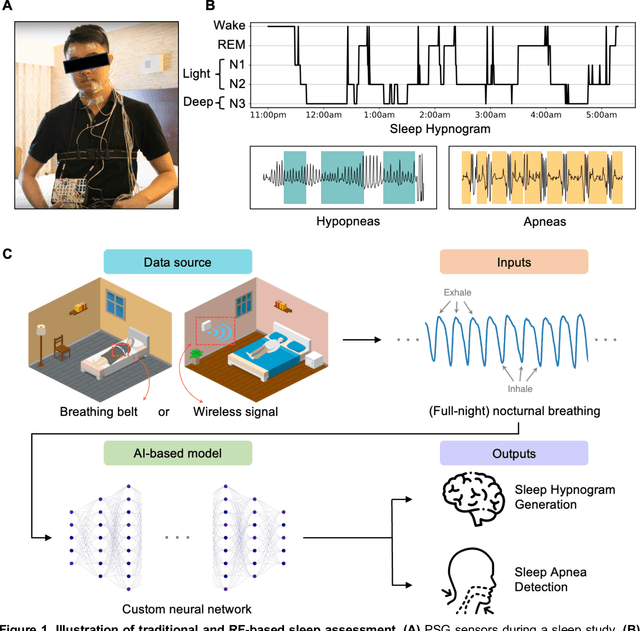
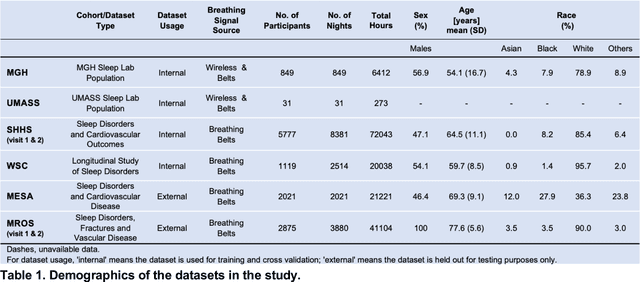
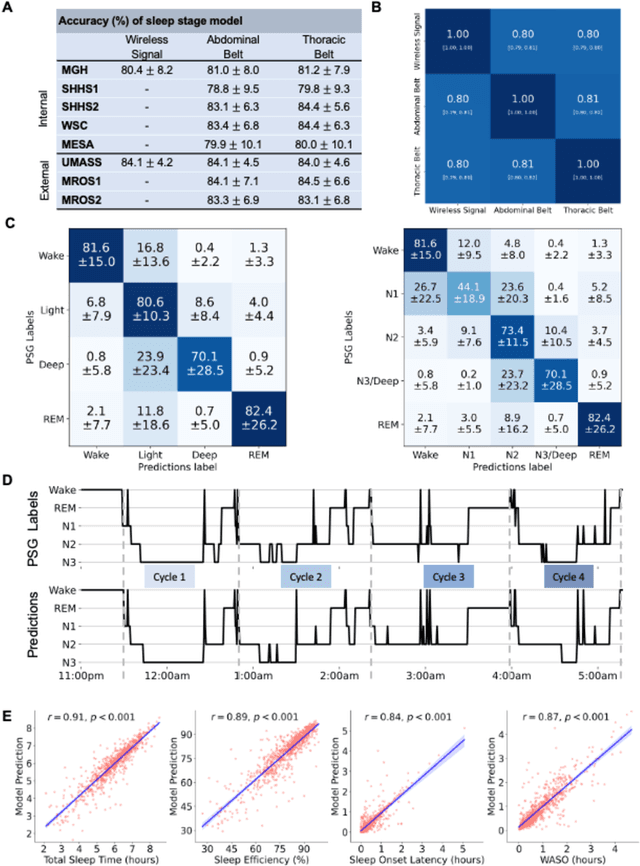
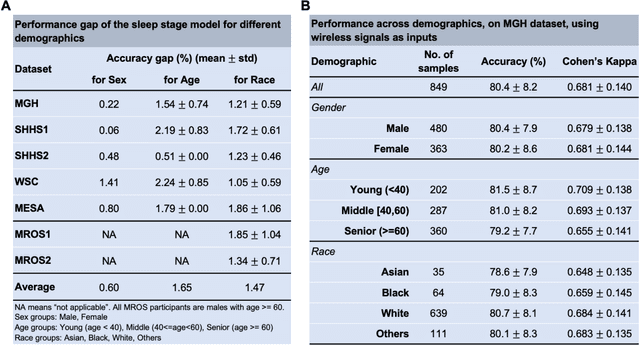
Abstract:The ability to assess sleep at home, capture sleep stages, and detect the occurrence of apnea (without on-body sensors) simply by analyzing the radio waves bouncing off people's bodies while they sleep is quite powerful. Such a capability would allow for longitudinal data collection in patients' homes, informing our understanding of sleep and its interaction with various diseases and their therapeutic responses, both in clinical trials and routine care. In this article, we develop an advanced machine learning algorithm for passively monitoring sleep and nocturnal breathing from radio waves reflected off people while asleep. Validation results in comparison with the gold standard (i.e., polysomnography) (n=849) demonstrate that the model captures the sleep hypnogram (with an accuracy of 81% for 30-second epochs categorized into Wake, Light Sleep, Deep Sleep, or REM), detects sleep apnea (AUROC = 0.88), and measures the patient's Apnea-Hypopnea Index (ICC=0.95; 95% CI = [0.93, 0.97]). Notably, the model exhibits equitable performance across race, sex, and age. Moreover, the model uncovers informative interactions between sleep stages and a range of diseases including neurological, psychiatric, cardiovascular, and immunological disorders. These findings not only hold promise for clinical practice and interventional trials but also underscore the significance of sleep as a fundamental component in understanding and managing various diseases.
Learning Vision from Models Rivals Learning Vision from Data
Dec 28, 2023



Abstract:We introduce SynCLR, a novel approach for learning visual representations exclusively from synthetic images and synthetic captions, without any real data. We synthesize a large dataset of image captions using LLMs, then use an off-the-shelf text-to-image model to generate multiple images corresponding to each synthetic caption. We perform visual representation learning on these synthetic images via contrastive learning, treating images sharing the same caption as positive pairs. The resulting representations transfer well to many downstream tasks, competing favorably with other general-purpose visual representation learners such as CLIP and DINO v2 in image classification tasks. Furthermore, in dense prediction tasks such as semantic segmentation, SynCLR outperforms previous self-supervised methods by a significant margin, e.g., improving over MAE and iBOT by 6.2 and 4.3 mIoU on ADE20k for ViT-B/16.
The Limits of Fair Medical Imaging AI In The Wild
Dec 11, 2023Abstract:As artificial intelligence (AI) rapidly approaches human-level performance in medical imaging, it is crucial that it does not exacerbate or propagate healthcare disparities. Prior research has established AI's capacity to infer demographic data from chest X-rays, leading to a key concern: do models using demographic shortcuts have unfair predictions across subpopulations? In this study, we conduct a thorough investigation into the extent to which medical AI utilizes demographic encodings, focusing on potential fairness discrepancies within both in-distribution training sets and external test sets. Our analysis covers three key medical imaging disciplines: radiology, dermatology, and ophthalmology, and incorporates data from six global chest X-ray datasets. We confirm that medical imaging AI leverages demographic shortcuts in disease classification. While correcting shortcuts algorithmically effectively addresses fairness gaps to create "locally optimal" models within the original data distribution, this optimality is not true in new test settings. Surprisingly, we find that models with less encoding of demographic attributes are often most "globally optimal", exhibiting better fairness during model evaluation in new test environments. Our work establishes best practices for medical imaging models which maintain their performance and fairness in deployments beyond their initial training contexts, underscoring critical considerations for AI clinical deployments across populations and sites.
Self-conditioned Image Generation via Generating Representations
Dec 08, 2023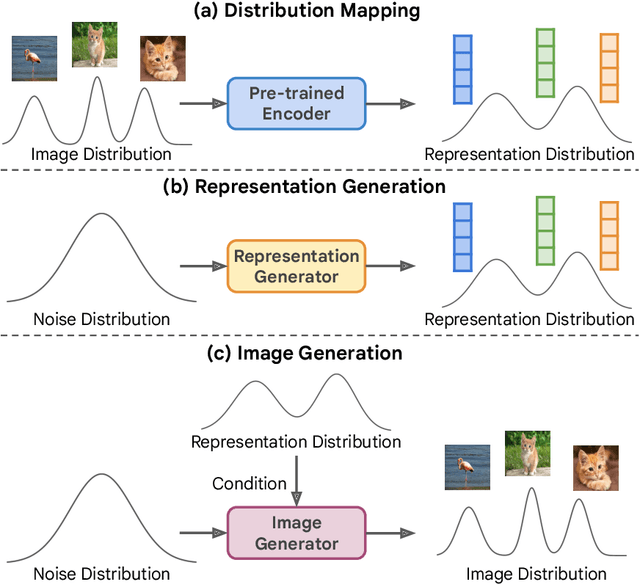
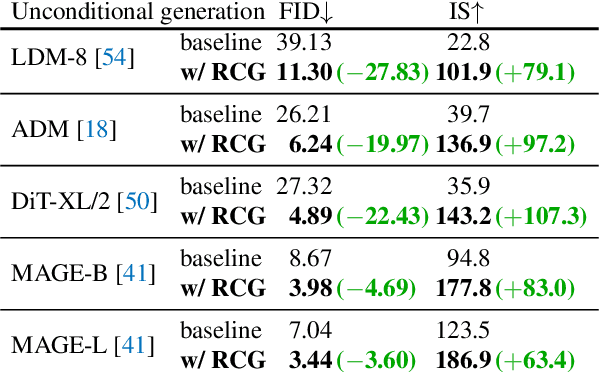
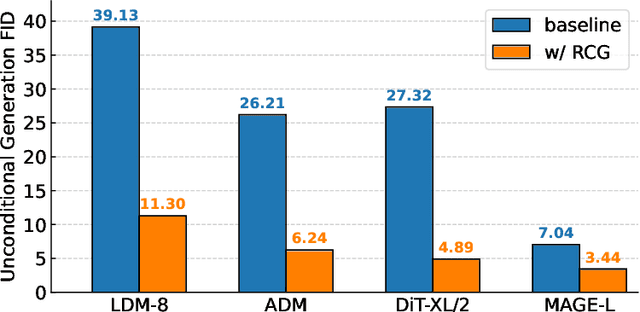
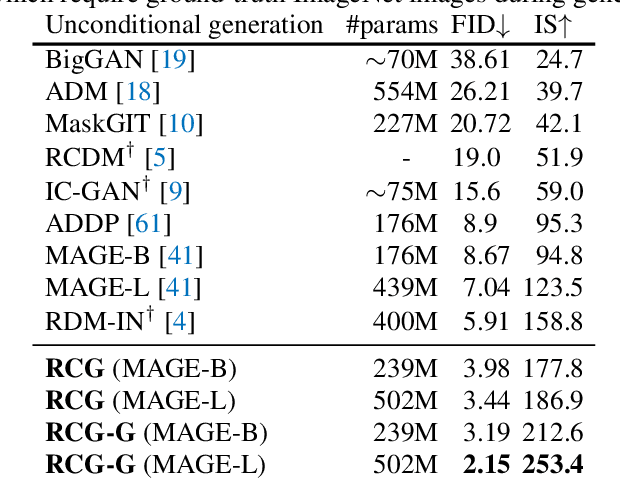
Abstract:This paper presents $\textbf{R}$epresentation-$\textbf{C}$onditioned image $\textbf{G}$eneration (RCG), a simple yet effective image generation framework which sets a new benchmark in class-unconditional image generation. RCG does not condition on any human annotations. Instead, it conditions on a self-supervised representation distribution which is mapped from the image distribution using a pre-trained encoder. During generation, RCG samples from such representation distribution using a representation diffusion model (RDM), and employs a pixel generator to craft image pixels conditioned on the sampled representation. Such a design provides substantial guidance during the generative process, resulting in high-quality image generation. Tested on ImageNet 256$\times$256, RCG achieves a Frechet Inception Distance (FID) of 3.31 and an Inception Score (IS) of 253.4. These results not only significantly improve the state-of-the-art of class-unconditional image generation but also rival the current leading methods in class-conditional image generation, bridging the long-standing performance gap between these two tasks. Code is available at https://github.com/LTH14/rcg.
Scaling Laws of Synthetic Images for Model Training for Now
Dec 07, 2023



Abstract:Recent significant advances in text-to-image models unlock the possibility of training vision systems using synthetic images, potentially overcoming the difficulty of collecting curated data at scale. It is unclear, however, how these models behave at scale, as more synthetic data is added to the training set. In this paper we study the scaling laws of synthetic images generated by state of the art text-to-image models, for the training of supervised models: image classifiers with label supervision, and CLIP with language supervision. We identify several factors, including text prompts, classifier-free guidance scale, and types of text-to-image models, that significantly affect scaling behavior. After tuning these factors, we observe that synthetic images demonstrate a scaling trend similar to, but slightly less effective than, real images in CLIP training, while they significantly underperform in scaling when training supervised image classifiers. Our analysis indicates that the main reason for this underperformance is the inability of off-the-shelf text-to-image models to generate certain concepts, a limitation that significantly impairs the training of image classifiers. Our findings also suggest that scaling synthetic data can be particularly effective in scenarios such as: (1) when there is a limited supply of real images for a supervised problem (e.g., fewer than 0.5 million images in ImageNet), (2) when the evaluation dataset diverges significantly from the training data, indicating the out-of-distribution scenario, or (3) when synthetic data is used in conjunction with real images, as demonstrated in the training of CLIP models.
Leveraging Unpaired Data for Vision-Language Generative Models via Cycle Consistency
Oct 05, 2023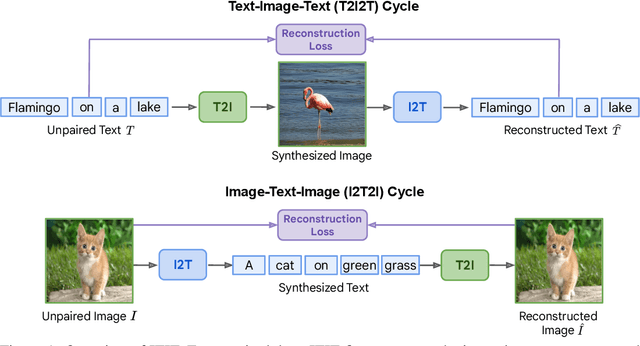
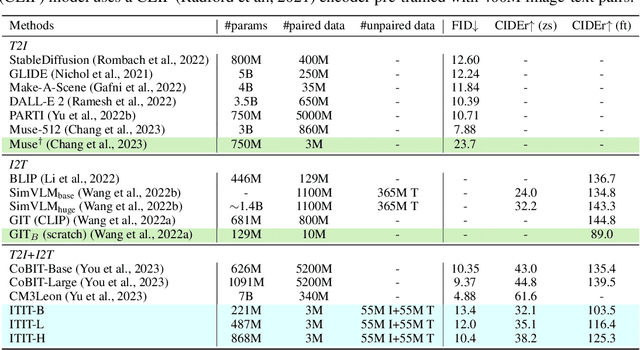
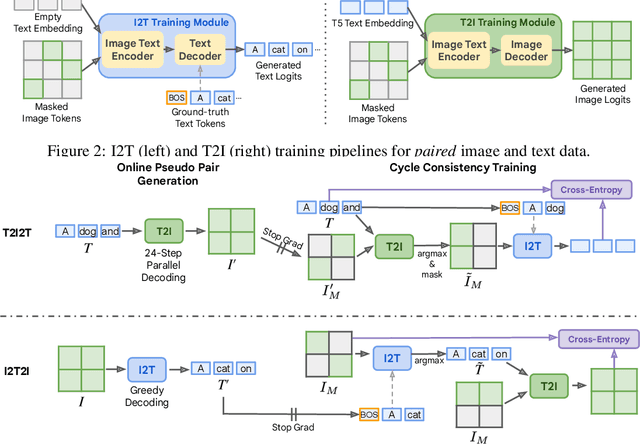
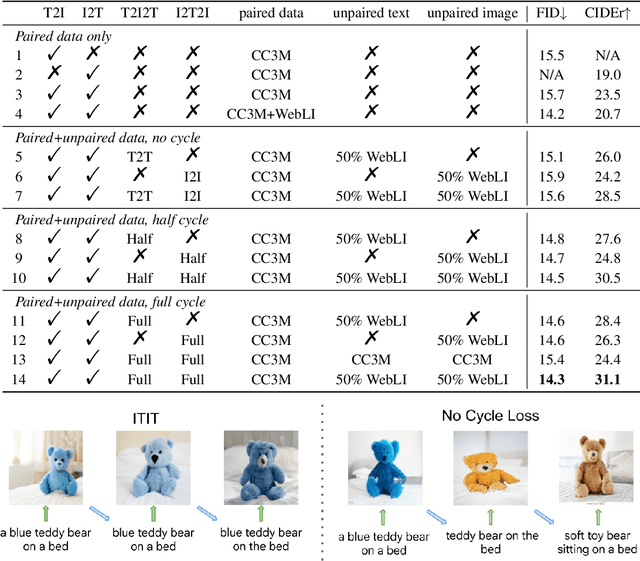
Abstract:Current vision-language generative models rely on expansive corpora of paired image-text data to attain optimal performance and generalization capabilities. However, automatically collecting such data (e.g. via large-scale web scraping) leads to low quality and poor image-text correlation, while human annotation is more accurate but requires significant manual effort and expense. We introduce $\textbf{ITIT}$ ($\textbf{I}$n$\textbf{T}$egrating $\textbf{I}$mage $\textbf{T}$ext): an innovative training paradigm grounded in the concept of cycle consistency which allows vision-language training on unpaired image and text data. ITIT is comprised of a joint image-text encoder with disjoint image and text decoders that enable bidirectional image-to-text and text-to-image generation in a single framework. During training, ITIT leverages a small set of paired image-text data to ensure its output matches the input reasonably well in both directions. Simultaneously, the model is also trained on much larger datasets containing only images or texts. This is achieved by enforcing cycle consistency between the original unpaired samples and the cycle-generated counterparts. For instance, it generates a caption for a given input image and then uses the caption to create an output image, and enforces similarity between the input and output images. Our experiments show that ITIT with unpaired datasets exhibits similar scaling behavior as using high-quality paired data. We demonstrate image generation and captioning performance on par with state-of-the-art text-to-image and image-to-text models with orders of magnitude fewer (only 3M) paired image-text data.
 Add to Chrome
Add to Chrome Add to Firefox
Add to Firefox Add to Edge
Add to Edge